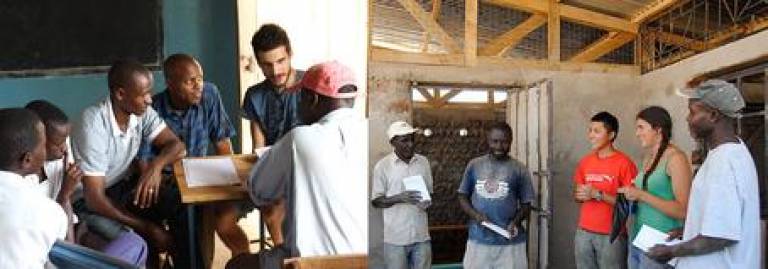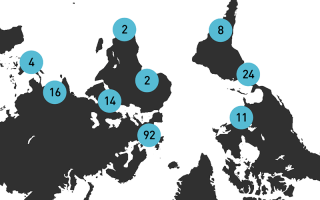Alberto and Kaiting recount their experiences of studying MSc Building & Urban Design in Developmentat the Development Planning Unit

Alberto Piccioli – from Italy – and Kaiting Chang (Cony) – from Taiwan – met during the BUDD course of 2013/14, working together on various assignments throughout the Master’s. With different backgrounds and trajectories, they both joined the Tanzanian organization C-re-aid (www.c-re-aid.org) in 2015.
Alberto has always been passionate about discovery, learning new cultures, languages and ways of living. As an architecture student, he came to see that a better understanding of the urban environment has become necessary to address the complexity of cities and settlements globally.
In particular, coming from a first world context, he believes that designers have to “step back” and get a wider picture, engaging and applying their skills for the majority of the world’s population. He realized that participatory design and engagement with the community are crucial aspects of his profession and can make a difference, both in the Global South and North.
Behind this lies the concept of listening and understanding the users’ needs in order to develop applicable solutions. Trying to use a more holistic approach and interacting with the key actors involved, professionals can address global poverty, urban informality, extreme marginalization and degradation, in the attempt of catalyzing change with active practice. As a matter of fact, he believes that it is through practice, applying the skills learned in theory, that built environment professionals can really make a difference. These are amongst the main reasons why he decided to join the BUDD course in London.
Born in 1987, Cony experienced the urban transformative time in her hometown during her teenage. She witnessed how the huge new high-rise building replaced the farm next to her house; she started to go to the movies in Japanese department stores instead of local theaters in the old town; her house gave way to a fancy international hotel and her family hence received a considerable compensation. All these small incidents cultivated her awareness of built environment - the spatial elements, the invisible force of change, and the people living in it.
With the interest of serving the public, she studied Urban Planning at National Chung Kung University and worked as urban planner in an urban consultant company in Taiwan after graduation. In her work she was able to grasp the merit of conventional planning systems and deliver the most appropriate outcome for each given circumstances. Yet she also realized that in such approach, it is rather common to avoid conflict by manipulating the public opinion and planning process without putting real effort to engage relative actors, especially the marginalized groups.
Questioning the role and power of built environment practitioners, she realized that her original intention of choosing this profession to improve the majority people’s life was too naive if she could not challenge the exiting power relations to respond the increasing complexities of urban reality, its form and dynamics. When she received her official certification of Urban Planning Engineer she felt an urge to challenge herself and broaden her perspective to gain a deeper understanding about how the urban reality was created with different actors, power and activities at global scale. When she found the DPU website she was immediately attracted by the BUDD course.
During the course, both Alberto and Cony worked on critical urbanism in Colombia, South East Asia and London; they went on a short trip to Brescia, Italy, to test learnings in the field with a local organization that works with political refugees and issues of social integration.
Throughout the year they were constantly exposed to international, diverse and stimulating talks and events, which greatly enriched the learning and individual experience. In May, the group finally went on an intense and rewarding field trip to Cambodia, which although brief and with a strong academic research component, gave the students the opportunity to step into reality and get a feeling of how development work can look like. Two of the major learnings from this experience were the meaning of flexibility and the complex interrelations of local and international actors in the field.
Overall, it must be said that this master’s was more about the people met along the way, than just the theory studied on books. Each individual with a different cultural and professional background, nationality, life experience, and each open and keen on becoming your friend. It was incredibly easy to find support and discuss about personal and work-related issues with the BUDD team; this intense relationship and commitment of students and staff, and the international exposure that this master’s and the whole academic environment offered, are probably the reasons why they would both embark on this journey again, despite the great amount of energy and stress that it entails!
For Alberto, architecture is the whole process of conceiving, designing, and constructing a building, involving the users proactively throughout several phases. In his opinion, architects should face the challenge of designing a good building with limited resources. They thus have to look for innovative and efficient solutions, working hand in hand with other professionals, and most importantly the people, in a process of creative exchange and empowerment that goes much beyond the construction itself. On these premises, on January 2015, he landed in Moshi, Tanzania, where his learnings and previous experience could find practical declination with the young and inspiring organization C-re-a.i.d.
C-re-a.i.d. is a Tanzanian non-profit which conducts research and practice on the role of architecture in the challenge of poverty alleviation and community empowerment. It does so by means of fieldwork, organizing design and construction, empowering local craftsmen and receiving students to carry out material changes that can reduce families’ vulnerability and trigger longer term improvements.
As an architecture intern, his main responsibilities were researching materials and affordable techniques, coordinating students’ projects, and working on a variety of other projects with innovative, sustainable and social components for C-re-aid’s architectural office. This turned out to be an extremely exciting hands-on experience, where he constantly learned by doing and earned invaluable research, practical and field experience. Moreover, as learned during the BUDD course, he constantly reflected critically back on his work, and he has been keeping a blog that records this experience at mycreaidexperience.weebly.com.
In July 2015, Cony joined C-re-aid as a volunteer for one of the students projects, for which she had to fundraise before arrival. The program provided an invaluable opportunity for her to put the developing skills to practical use. Being interested in community engagement, she chose a community project together with another architecture graduate. They designed and built a community shop for a women’s group in a rural area.
As the project leader, she was responsible for the material research, budget control, logistics and managing the construction work with limited resources and time. In her work she tried to involve the women in the process of building and empower the local craftsmen by applying new building techniques. Her project and personal reflection can be found on her blog: conychang21.wix.com/conyinmoshi.
While in academia, Alberto was looking at things through computer screens and on libraries’ desks, trying to discuss theories and overarching strategies before actually thinking of what small steps are needed to realize them. However, in his opinion those small actions are the ones that can initiate change and testing their implementation should be the aim of the fieldwork.
Without underestimating the importance of a thorough and complex understanding of the case, this should be a starting point, while the core of the profession is then the set of concrete actions that are taken, through a process of trial and error, to eventually scale them up, including them in an overall strategy. As a former student of architecture, the spatial dimension is essential for him, and cannot be left aside. In the future he intends to focus mostly on how the production of space can be used in transformative ways and especially on how design is central in this process. The BUDD course was undoubtedly the springboard for his future career, where he will put in practice this holistic and people-centered approach to architecture and life!
For Cony, even with the prepared mind of pushing herself out of her comfort zone, the intensive and multidisciplinary BUDD course has destroyed her faith several times with the never-ending critical reflection on herself, her work and past experience. At the end, she look back and realized that it is a necessary process to enrich her niche in this profession and formulate her skills in a more mature and responsible manner. With her diverse theoretical and practical experiences she believes that the fundamental value of urban design reposes in its social dependency. In the future she aims to drive her career toward participatory approaches to bridge the conversation between planning system and community-based action in both developing and developed contexts.
 Close
Close


